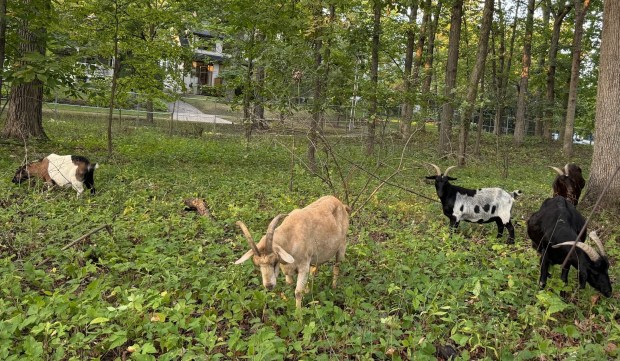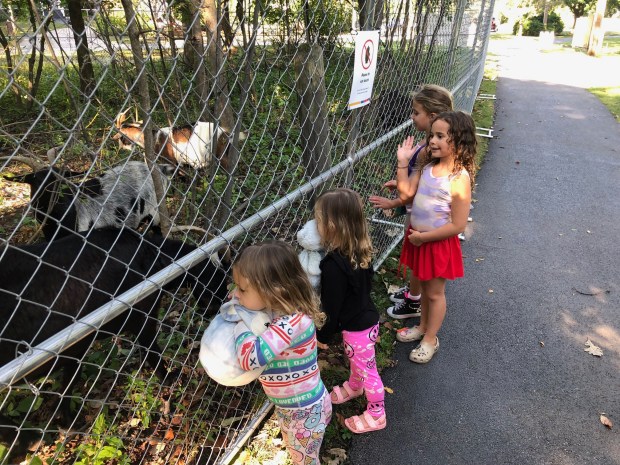Goats don’t usually need any encouragement to eat, so the Glencoe Park District is employing them, once again, to chow down to get rid of invasive plant species. The goats’ hearty appetites mean the park district won’t have to put chemicals in the soil or employ human sweat equity.
Last week, a herd of goats which munched on invasive species at the Milton Park grounds in May came back to once again fill their bellies. The Glencoe Park District said more than 800 people stopped by to take a look at the animals.
The goats still had work to do to get rid of the plants that prevent desirable plants from blooming.
“This kind of method of continual grazing just helps to weaken the spread and growth of the invasive species, especially buckthorn, which is very prevalent in the space,” explained Administrative Support and Special Projects Manager Erika Doroghazi, the leader of the Park District’s Green Team. “What we are trying to do is get rid of the invasive species, which in their nature grow back pretty quickly.”
Doroghazi sensed some positivity in the initial effort connecting the hearty appetites of the goats to improved sightlines at Milton Park.
Buoyed by the initial success, Park District officials authorized another goat (and accompanying fence) rental that will cost between $3,000 to $4,000, according to a Park District spokeswoman.
Starting on the afternoon of Sept. 23, the animals were once again on display, albeit a smaller herd this time with only about 12 as opposed to more than 20 the first time around. Some of them were making a return trip, according to Doroghazi.
“We were joking that some of them knew what to do because they got right to it when they got here,” she said.
Upon arrival, the goats, of different colors and ages, went to work in a fenced off area and stayed there rain or shine. The goats roamed around the 1.6-acre space devouring anything that was in the ground, most of which was invasive species.
Like the last time, intrigued children and adults gawked while standing behind a chain link fence.
The admirers included Alexis Ruda, who teaches in Glencoe.
“They are absolutely adorable and the fact that they are preforming a helpful benefit for our environment is doubly beneficial. But I just came because they are so cute and it is not something you would see in Glencoe every day,” she said.
Kim Bloomberg lives just a couple of houses down from Milton, marveling at her temporary neighbors.

“I feel really privileged that is it at our local park. We have a tight-knit block, so all the people with young kids are excited,” she said.
Bloomberg noted she did not catch the first goat appearance last May, as she was out of town at the time. “I missed it and I was very sad about it. Everybody was talking about it.”
Glencoe’s Deanna Stallsmith was taking a video for her children, pointing out how the goats seemed oblivious to the roaring cars heading down Dundee Road.
“They don’t seem bothered by the traffic,” she said. “That was kind of surprising. They are very focused on their work.”
Doroghazi was not sure if there would be another goat appearance. She indicated that it is up to other staff and the board.
Yet for now, she is very happy with the initial results.
“It’s nice to see a controlled method that is eco-friendly that doesn’t use chemicals,” she said. “And it doesn’t put a huge burden on our staff.”





